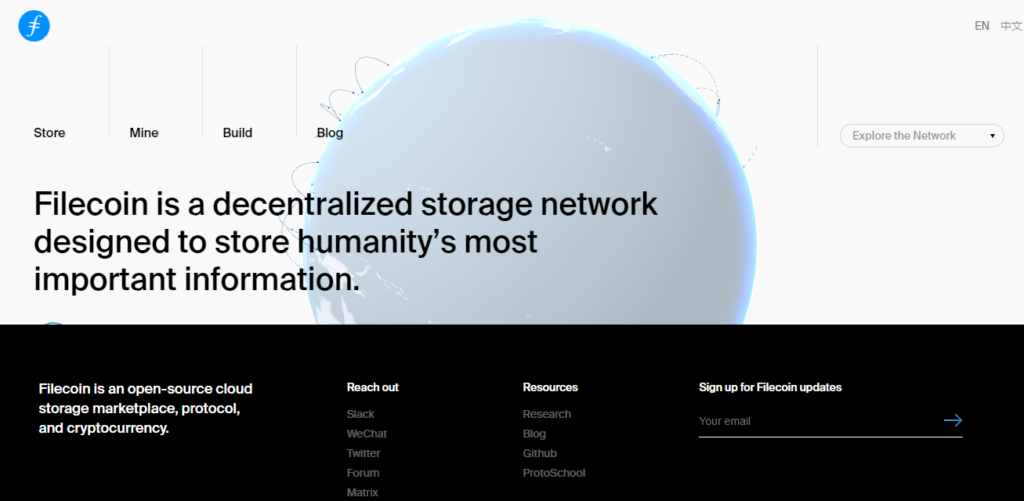What does the Filecoin cryptocurrency do? Filecoin is a unique project combining blockchain technology and peer-to-peer cloud file storage.
If a network aims to ‘store humanity’s most important data’ using the blockchain, then the project must be quite ambitious. Enter Filecoin, a cryptocurrency that has been on this very mission since 2017.

The project’s popularity certainly shows in the CoinMarketCap rankings as it’s now the 24th most traded coin at the time of writing, boasting a market cap of about $7.7 billion. Presently, one FIL (⨎) costs around $77, with more than 101 million coins in circulation.
Filecoin proves yet again the possibilities of using blockchain technology for a myriad of applications outside of run-of-the-mill payment systems like Bitcoin. Cloud file storage has been a booming industry for some time, but it is plagued by cost, monopoly, and data control issues.
Filecoin is undoubtedly one of the unique blockchain-based inventions, warranting a closer look into how it started, how it works, and why it’s at a high position in the cryptocurrency industry.
Beginnings of Filecoin
Like most cryptocurrencies, the developers of Filecoin published a whitepaper in July 2017 entitled ‘Filecoin: A Decentralized Storage Network.’ The whole concept has always been employing a decentralized approach to the current storage mechanisms provided by Dropbox, Amazon Web Services, Google Drive, OneDrive, etc.
As with anything centralized, we encounter several problems related to censorship, data control, and costs. Filecoin is an addition to an already-existing P2P file-sharing protocol known as the IPFS (InterPlanetary File System). The IPFS operates similarly to BitTorrent, where a host of connected computers share and receive files.
The IFPS, released in February 2015, is a product of the Protocol Labs, a San Francisco-based R&D lab that has built a host of cutting-edge, internet-based applications over the years.
Juan Benet, an American computer scientist, founded the IFPS and is the current CEO of Protocol Labs, which he started in May 2014. Like most cryptocurrencies, Filecoin had an initial coin offering well before it publicly launched. This event ran from 10 August 2017 to 07 September 2017, reportedly raising over $250 million, which was a record at the time.
Filecoin remained in the testing phase for several years and only officially went for public trade in mid-October 2020.
How does Filecoin work?
At its core, Filecoin is a decentralized, open-source blockchain-based file storage protocol, a cooperative marketplace for storing and retrieving your data. It is essentially a layer on the existing IPFS technology by using cryptocurrencies as payment and rewards for mining.
To understand how the system works overall, we have two participants within the network, clients and storage/retrieval miners. The miners provide their unused hard drive space for clients to rent for a small fee.
Nothing is off-limits for storage since you can store anything from personal files and videos to complex websites and security archives. So, why would you consider Filecoin over a service like Dropbox?
Well, one has an extensive range of storage facilities filtered according to the best price, storage duration, speed, disc space, and efficiency. You have the option of encrypting your data for privacy concerns.
Users on the network pay the storage miners using FIL, the network’s native token that is mined. Another massive advantage of Filecoin is its hypercompetitive pricing compared to other centralized file storage companies.
Because Filecoin produces substantial economies of scale, you have a wide range of storage providers competing for your business, lowering the overall costs. Moreover, miners have an incentive to provide as much space as possible due to the mining rewards.
Filecoin’s ledger
While we’ve referenced mining numerous times, Filecoin’s ledger doesn’t technically rely on proof-of-work or mining. Instead of something like Bitcoin, where power is dictated by how powerful the computers are on the network, Filecoin assesses how much space each participant adds.
‘Miners’ are rewarded not for how advanced their machines are but for how much space they contribute from storing clients’ files. Hence, Filecoin relies on different consensus mechanisms than proof-of-work known as proof-of-spacetime (PoSt) and proof-of-replication.
Once a deal has been struck with a user and a miner, a client locks up funds released incrementally to the latter.
Proof-of-spacetime and proof-of-replication simply mean miners are required to submit proof every 24 hours to the blockchain to verify the data is being kept appropriately and securely for the contract duration to prove they aren’t cheating.
Doing this ensures they can continue earning the storage fees as they are released to them cumulatively. Failure to do so results in a penalty known as a fault fee. Miners can also earn from the natural block rewards (not from the client) that are responsible for ‘minting’ new FIL tokens.
These come randomly from the network itself through a series of defined epochs or periods based on how much space a miner provides to the IPFS. This mechanism is known as winning proof-of-spacetime or WinningPoSt.
While it’s difficult to say how much miners earn, each block forms about every 30 seconds.
Final word: what makes Filecoin valuable?
Understanding what makes Filecoin special needs a comparison between other file storage services and also cryptocurrencies. One of the advantages of something like Filecoin is the pricing structure which works out cheaper than other centralized services because of the economies of scale involved.
This is different from the corporate pricing used by the known brands in the industry. Moreover, instead of a number of people who could access your data after it’s been stored, there is far less control if you’re relying on one miner to do the job.
If something were to go wrong, there is no human intervention required due to the autonomous nature of the protocol, unlike with other services where you would spend time dealing with customer support.
Lastly, there is a much lower and accessible barrier to entry to becoming an independent storage provider. From a cryptocurrency perspective, you don’t necessarily need expensive ASIC machines like other coins. As you’re dealing with storage, what matters more is the size of your hard drives and less so on how advanced your computer is.
Consequently, Filecoin is more environmentally friendly since it does not perform power-consuming mining like Bitcoin and Ethereum. Ultimately, Filecoin is yet another example of one of the leading second-generation blockchains in the industry.








